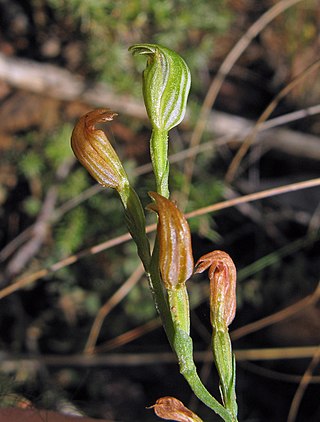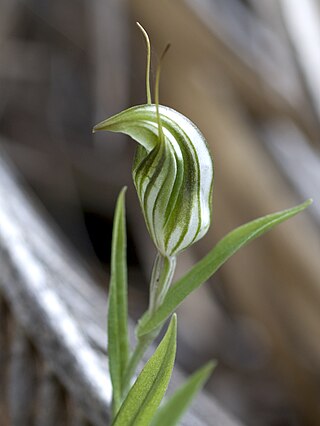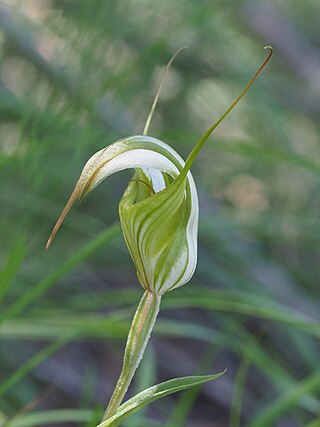
Pterostylis grandiflora, commonly known as the cobra greenhood or superb greenhood, is a species of orchid endemic to south-eastern Australia. As with similar orchids, the flowering plants differ from those which are not flowering. The non-flowering plants have a rosette of leaves but the flowering plants lack a rosette and have a single flower with leaves on the flowering spike. This greenhood has a green and white, striped flower with deep red-brown markings especially on its "galea", and a sharply pointed dorsal sepal.

Pterostylis atrans, commonly known as the dark-tip greenhood or blunt-tongue greenhood, is a species of orchid endemic to south-eastern Australia. As with similar greenhoods, plants in flower differ from those that are not flowering. The non-flowering plants have a rosette of leaves flat on the ground, but the plants in flower have a single flower with leaves on the flowering spike. In this species, the flower is green and reddish brown with a protruding sinus and small club-like tips on the ends of the lateral sepals.

Pterostylis decurva, commonly known as the summer greenhood, is a species of orchid endemic to south-eastern Australia. As with similar greenhoods, the flowering plants differ from those which are not flowering. The non-flowering plants have a rosette of leaves but the flowering plants have a single flower with leaves on the flowering spike. This greenhood usually flowers in summer and has a white flower with green stripes and a brownish tinge. It is similar to P. aestiva but has paler green flowers.

Pterostylis parviflora, commonly known as the tiny greenhood, is a species of orchid endemic to south-eastern Australia. As with similar orchids, the flowering plants differ from those which are not flowering. The non-flowering plants have a rosette of leaves but the flowering plants lack a rosette at the base but have up to eight tiny green, white and brown flowers.

Pterostylis revoluta, commonly known as the autumn greenhood, is a species of orchid endemic to south-eastern Australia. As with similar greenhoods, the flowering plants differ from those which are not flowering. The non-flowering plants have a rosette of leaves flat on the ground but the flowering plants have a single flower with leaves on the flowering spike. This greenhood has white and green flowers that have a long, curved, pointed labellum which extends beyond the sinus between the lateral sepals.

Pterostylis scabra, commonly known as the green-veined shell orchid, is a species of orchid endemic to the south-west of Western Australia. As with similar orchids, the flowering plants differ from those which are not flowering. The non-flowering plants have a rosette of leaves but the flowering plants lack a rosette and have a single flower with leaves on the flowering spike. This greenhood has a white flower with green and pale brownish-fawn stripes and a long, curved protruding labellum. It is found in inland areas between Kalbarri and Esperance.

Pterostylis scabrida, commonly known as the rough greenhood, is a species of orchid endemic to Tasmania. It has a rosette of leaves at the base of the plant and a single green and white flower on a rough stem. It is widespread and common in wet forests and is one of the few species of Pterostylis to grow in rainforest.

Pterostylis tenuissima, commonly known as the swamp greenhood, is a species of orchid endemic to the southern mainland of Australia. As with similar greenhoods, the flowering plants differ from those which are not flowering. The non-flowering plants have a rosette of leaves flat on the ground but the flowering plants have a single flower with leaves on the flowering spike. This greenhood has small translucent white flowers with dark green stripes and markings and both the dorsal sepal and lateral sepals have relatively long, thread-like tips.

Pterostylis aneba is a species of orchid endemic to south-eastern Australia. It is a recently described and poorly-known greenhood similar to Pterostylis alpina and P. monticola. It has a rosette of fleshy leaves at the base of the plant and a single green and white flower. It grows in alpine and sub-alpine habitats.

Pterostylis longipetala, commonly known as the curved greenhood, is a species of orchid endemic to eastern Australia. As with similar greenhoods, the flowering plants differ from those which are not flowering. The non-flowering plants have a rosette of leaves flat on the ground but the flowering plants have a single flower with leaves on the flowering spike. This greenhood has dark green, brown and white flowers which lean slightly forwards and have sharply-pointed petals and a long, curved labellum.
Pterostylis alata, commonly known as striped greenhood, is a species of orchid endemic to Tasmania. As with similar orchids, the flowering plants differ from those which are not flowering. The non-flowering plants have a rosette of leaves but the flowering plants have a single flower with leaves on the flowering spike. This greenhood has a white flower with prominent dark green stripes and a sharply pointed, brown-tipped dorsal sepal. Similar greenhoods growing on the Australian mainland were formerly known as Pterostylis alata but are now given the name Pterostylis striata.

Pterostylis striata, commonly known as the mainland striped greenhood, is a species of orchid endemic to south-eastern mainland Australia. As with similar orchids, the flowering plants differ from those which are not flowering. The non-flowering plants have a rosette of leaves but the flowering plants have a single flower with leaves on the flowering spike. This greenhood has a white flower with prominent dark green stripes and a brown-tipped dorsal sepal with a thread-like tip. Mainland striped greenhoods were formerly described as Pterostylis alata but that species is now recognised as a Tasmanian endemic.

Pterostylis falcata, commonly known as the sickle greenhood, is a species of orchid endemic to south-eastern Australia. It has a rosette of bright green leaves at the base of the plant and a single green and white, sickle-shaped flower. It is widespread and often common in Victoria but also occurs further north and west, and in Tasmania
Pterostylis agathicola, commonly known as kauri greenhood, is a species of orchid endemic to the North Island of New Zealand. As with similar greenhoods, the flowering plants differ from those which are not flowering. The non-flowering plants have a rosette of leaves flat on the ground but the flowering plants have a single flower with leaves on the flowering spike. It grows almost exclusively in kauri forest and has a relatively large green and transparent white flower.
Pterostylis aphylla, commonly known as the leafless greenhood, is a species of orchid endemic to Tasmania. As with similar greenhoods, the flowering plants differ from those which are not flowering. The non-flowering plants have a rosette of leaves flat on the ground but in this species, the flowering plants have a single green and white flower with a brown tip and lack leaves apart from a few small scales.
Pterostylis aquilonia, commonly known as the northern cobra greenhood, is a species of orchid endemic to Queensland. As with similar orchids, the flowering plants differ from those which are not flowering. The non-flowering plants have a rosette of leaves, but the flowering plants lack a rosette and have a single flower with leaves on the flowering spike. This greenhood has a relatively large green, white and reddish-brown self-pollinating flower.
Pterostylis dubia, commonly known as the blue-tongued greenhood, is a plant in the orchid family Orchidaceae and is endemic to Tasmania. It has a rosette of fleshy leaves at its base and a dark green and white flower with narrow petals and a dark blue-green labellum.

Pterostylis hildae, commonly known as the rainforest greenhood, is a species of orchid found in eastern Australia. It has a rosette of leaves and when flowering a rosette at the base of a flowering stem with a single green, white and brown flower. It is found in wet forests, including rainforest in New South Wales and Queensland.
Pterostylis paludosa, commonly known as swamp greenhood, is a species of greenhood orchid endemic to New Zealand. As with similar orchids, plants in flower differ from those that are not. Those not in flower have a rosette of leaves on a short stalk but plants in flower lack a rosette and have a single flower with leaves on the flowering spike. This greenhood has a translucent white flower with pale to yellowish-green stripes.

Pterostylis reflexa, commonly known as the dainty greenhood, is a species of orchid endemic to New South Wales. As with similar greenhoods, the flowering plants differ from those which are not flowering. The non-flowering plants have a rosette of leaves flat on the ground but the flowering plants have a single flower with leaves on the flowering stem. This greenhood has a relatively large white, green and light brown flower with a long, curved dorsal sepal and a protruding labellum.













